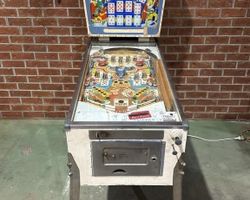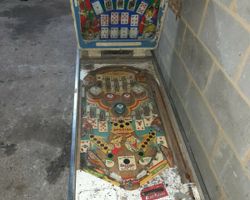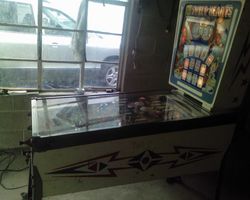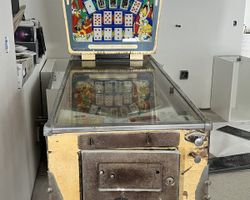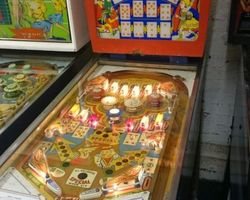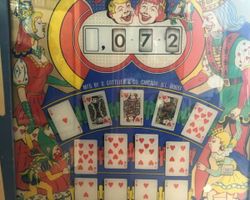Sweet Hearts
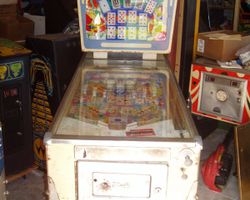
Average Prices: USD $400 to $900
Produced: September, 1963
Production Run: 4,450 units
Machine Type: Electro-mechanical
Players: 1
Design by: Wayne Neyens
Art by: Roy Parker
Sweet Hearts, released in September 1963 by D. Gottlieb & Co., represents a distinctive moment in electro-mechanical (EM) pinball history. Designed by the prolific Wayne Neyens, who also contributed to its concept, animation, and mechanical engineering, Sweet Hearts emerged during a vibrant era for the pinball industry. The machine's visual identity was shaped by the artistry of Roy Parker, whose work became a hallmark for Gottlieb during this period. With a production run of 4,450 units, model number 200, Sweet Hearts was a substantial release, reflecting Gottlieb's commitment to delivering engaging gameplay experiences. Its theme, centered around playing cards and casino imagery, was a popular choice that resonated with a broad audience, offering a familiar yet fresh visual appeal. Notably, Sweet Hearts holds a unique place in Gottlieb's lineage as the final EM game from the manufacturer to incorporate a gobble hole, a playfield feature that would soon fade from general pinball design. This historical distinction alone marks it as a machine of particular interest for collectors and enthusiasts tracing the evolution of pinball mechanics. An interesting historical detail, often overlooked, is the appearance of USPS Zip Codes on the machine's backglass, coinciding with their introduction in the United States, subtly rooting the machine in the cultural landscape of its release year.
Sweet Hearts distinguishes itself with a combination of timeless pinball features and specific design choices that define its character. Central to its playfield experience is the V-shaped cluster of five pop bumpers positioned prominently at the top. These bumpers are engineered to create rapid, unpredictable ball movement and consistent scoring opportunities, providing a lively upper playfield. Below this action, the machine features two flippers at the bottom, two slingshots on either side, and two standup targets positioned strategically to encourage precise aiming. The most discussed and historically significant feature, however, is the gobble hole, located centrally on the lower playfield. Its inclusion, particularly as the last of its kind for Gottlieb, transforms it from a simple drain into a high-stakes, high-reward element of gameplay. The artwork by Roy Parker, especially evident on the playfield, contributes significantly to the machine's appeal. His classic illustration style imbues the card-themed elements with a warm, inviting aesthetic, making the playing surface visually captivating. The mechanical reel display further grounds the machine in its EM origins, with points registering audibly and visually through satisfying clunks and clicks, culminating in a maximum displayed score of 1,999 points. These design elements collectively enhance the pinball experience by providing both immediate, reactive fun and deeper strategic objectives.
The playfield layout of Sweet Hearts is meticulously designed to foster a challenging yet rewarding experience. At the top of the playfield are a series of rollover targets representing playing cards, specifically '10' through 'ACE' along the upper bank, and '2' through '5' and '6' through '9' on the sides. These rollovers are integral to the game’s primary objective: completing card sequences. Below these, the cluster of five pop bumpers dominates the upper-middle area, serving as a chaotic scoring zone that often funnels the ball into unexpected trajectories. The design philosophy behind this layout emphasizes skill and precise shot execution. Players are encouraged to master the initial plunger shot to direct the ball directly into the pop bumper area, maximizing early points and setting up subsequent plays. The two flippers are positioned to allow for controlled shots at the various rollovers and standup targets, while the two slingshots provide reactive deflection and maintain ball speed. The lower playfield, however, introduces a critical challenge: narrow openings around the central gobble hole. This design choice demands careful ball control, as a misplaced shot or an uncontrolled ricochet can lead to a swift, unforgiving drain. The interplay of these elements creates a flow that requires players to balance aggressive scoring in the pop bumper zone with strategic aiming to complete card sequences, all while navigating the risk posed by the gobble hole. Roy Parker's vibrant artwork on the playfield integrates seamlessly with this layout, with card suits and numbers clearly delineating targets, enhancing player immersion and making strategic objectives intuitive despite the game's inherent difficulty. The lighting, while standard for an EM of its era, effectively highlights active targets and scoring opportunities, guiding the player's focus.
Gameplay in Sweet Hearts is a test of precision, timing, and strategic thinking. The core progression revolves around completing the various card sequences formed by the playfield rollovers. Each successful rollover pass contributes to lighting a specific card, with the ultimate goal of completing entire suits or runs. The primary objective is to light all rollovers—the '10' through 'ACE' at the top, and the '2-5' and '6-9' on the sides—to activate the "All Rollovers" special, also known as the "purple special." This achievement awards a replay for any subsequent rollover activated, a highly coveted reward that shifts the game's focus from mere scoring to continuous replay opportunities. Beyond the rollovers, the gobble hole plays a pivotal role in the game’s unique objectives. By completing specific rollover sequences before the ball drains into the gobble hole, players can activate one of three distinct gobble hole specials, each awarding replays. This creates a high-risk, high-reward scenario, transforming what would typically be a frustrating drain into a potential pathway to bonus games, sometimes even up to triple replays. The game also allows for skill shots with the manual plunger, offering an initial opportunity to guide the ball directly into the chaotic, point-rich pop bumper area. An interesting aspect of Sweet Hearts gameplay, discovered by players over time, involves a "trade secret" trick: bouncing the ball off the card tray corner near the gobble hole. This technique, while challenging to execute, can extend ball time and create opportunities for higher scores and more replays, adding a layer of advanced strategy beyond the inherent design. The scoring system is straightforward, accumulating points displayed on mechanical reels, with the sounds of bells and Gottlieb's signature chimes accompanying each score and special award, providing clear, satisfying feedback.
Sweet Hearts has garnered a generally positive reception within the pinball community, particularly among enthusiasts of electro-mechanical machines. It is widely regarded as a highly enjoyable and challenging classic Gottlieb title, often described as a "player's game" that demands skill, strategy, and adept nudging. Its strengths are frequently highlighted, with Roy Parker's playfield artwork consistently praised as beautiful and a defining characteristic of the machine's aesthetic appeal. The V-shaped arrangement of the five pop bumpers is a particular point of acclaim, providing fast action and contributing significantly to the machine's high replayability. Many players express a strong desire for "just one more game" to achieve the elusive card sequences or beat their high scores. The unique gameplay elements, such as the three gobble hole specials and the "All Rollovers" special, are major draws, compelling players to master the challenging objectives. Its status as Gottlieb's last gobble hole game lends it historical significance, making it a desirable piece for collectors interested in the evolution of pinball design. Sweet Hearts is often cited as a prime example of why Gottlieb maintained a dominant position in the pinball market throughout the 1960s, showcasing their design philosophy of balancing scoring opportunities with challenging objectives.
However, Sweet Hearts is not without its points of contention. The very feature that defines its historical significance—the gobble hole—is also a source of frustration for some players. Described as "irritating," it can lead to quick drains and "pin-death," especially for those less skilled at navigating its narrow surrounding lanes. The extreme difficulty in lighting all the card sequences and collecting specials, while a positive for those seeking a challenge, can deter some players who prefer a more immediately rewarding experience. While the playfield artwork receives widespread praise, the backglass artwork is occasionally described as dated by a few. Some reviewers have also noted a "primitive" feel compared to other machines of its era, and the maximum scoring capacity of 1,999 points is sometimes seen as too low, capping the competitive potential. Despite these minor criticisms, the consensus remains that Sweet Hearts is a standout Gottlieb EM, highly regarded for its engaging gameplay and beautiful presentation. Its influence lies in its embodiment of Gottlieb's design ethos: creating machines that require genuine player skill and strategic depth, rather than relying solely on chance. This philosophy, exemplified by features like the complex card sequences and the high-stakes gobble hole, contributed to shaping player expectations and design trends for future EM and even early solid-state machines that emphasized strategic objectives and skilled play.
Sponsored Links
 Ebay Listings
Ebay Listings
 Auction Results
Auction Results
| Cost | Location | Date |
|---|---|---|
| AUD $325 |  Victoria, Australia Victoria, Australia |
20 February, 2025 |
| USD $750 |  Florida, United States Florida, United States |
21 March, 2024 |
| USD $1,450 |  California, United States California, United States |
28 September, 2022 |
| GBP £375 |  Bexhill, United Kingdom Bexhill, United Kingdom |
27 March, 2022 |
| USD $610 |  New York, United States New York, United States |
01 March, 2021 |
| EUR €500 |  Bayern, Germany Bayern, Germany |
20 January, 2021 |
| USD $1,250 |  United States United States |
30 December, 2020 |
| USD $1,200 |  Ohio, United States Ohio, United States |
21 September, 2020 |
| USD $675 |  Maryland, United States Maryland, United States |
08 March, 2020 |
| USD $1,195 |  Pennsylvania, United States Pennsylvania, United States |
20 November, 2019 |


Private Policy · Search Website · Contact Us
As an eBay Partner, we may earn a commission from qualifying purchases made through links on this site, at no additional cost to you.
All trademarks and copyrighted materials remain property of their respective owners. All other content copyright 2007 - 2025 Pinpedia.

